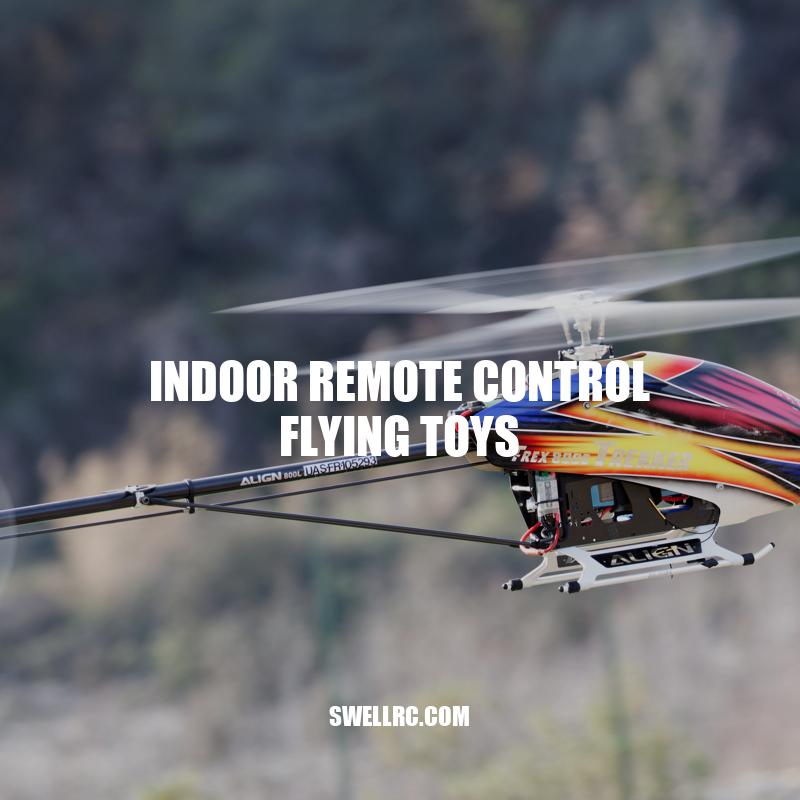Indoor Remote Control Flying Toys: Tips, Top Picks, and Safety Measures.
Indoor remote control flying toys are one of the newer hobbies taking the world by storm. These toys, also known as drones or quadcopters, are typically small flying machines that are controlled remotely by a user. They typically consist of a frame, motors, propellers, a battery, and a remote control system. Indoor remote control flying toys have become incredibly popular due to their versatility and ease of use. They are relatively easy to learn how to fly and offer endless creative possibilities for those who love to explore and experiment. The technology behind these toys has advanced quite a bit in recent years; today’s models are lighter, more durable, and more efficient than ever before. They are also more affordable, allowing hobbyists to experiment with different models and types of drones. Whether you are a professional photographer, video producer, or just someone who loves flying toys, indoor remote control flying toys offer a fascinating and addictive experience. In this article, we’ll explore some of the benefits of this hobby, from improving your motor skills and hand-eye coordination to reducing stress and anxiety. We will also look at the factors you should consider before buying your first indoor remote control flying toy and the safety tips that you should follow to avoid accidents. By the end of this article, you should have a good understanding of indoor remote control flying toys, and you’ll be ready to start exploring this fascinating and addictive hobby.
Understanding the working of Indoor Remote Control Flying Toys
Indoor remote control flying toys typically operate with the following components:
- Frame: the structure that holds all other components together and provides support and stability to the toy.
- Motors: the devices that power up the propellers and generate the thrust that moves the toy around.
- Propellers: the fans that generate the lift and thrust for the toy to fly around.
- Battery: the device that provides power to the motors and propellers.
- Remote control system: the technology that allows the user to control the toy’s movements from a distance.
There are several types of indoor remote control flying toys, each with specific features and advantages. Some models come equipped with cameras or sensors that allow them to capture images or avoid obstacles. Others are designed for acrobatics or speed, with the ability to do flips and rolls in the air. Regardless of the type, indoor remote control flying toys are incredibly fun to use and perfect for exploring, experimenting, and having a good time. To learn more about how indoor remote control flying toys work, there are several websites that offer detailed explanations and tutorials. For example, The Spruce Crafts provides a guide on how to build your own drone from scratch, while Drone Rush offers reviews of the latest models and accessories.
How does a remote control helicopter work?
A remote control helicopter works by using radio controls to remotely control its movements. The radio control system typically has two sticks used to control the helicopter’s pitch, yaw, throttle, and roll movements. The left stick controls pitch and yaw movements, while the right stick controls throttle and roll movements. For more information, you can check out the Wikipedia page on radio control systems.
Indoor remote control flying toys are more than just a fun pastime. Here are some benefits of using these devices:
- Improving motor skills and hand-eye coordination: using a remote control to operate a flying toy requires precision and coordination, which can strengthen these skills over time.
- Boosting creativity and concentration: flying toys allow users to explore and experiment, creating new challenges and coming up with innovative ways to use them. This can help improve creativity and concentration.
- Reducing stress and anxiety: controlling a flying toy can be a relaxing and enjoyable experience, which can help reduce stress and anxiety levels.
- Learning about technology: flying toys operate with various types of sensors, motors, controllers, and other components, offering an opportunity to learn about technology and engineering principles.
- Meeting new people: flying toy enthusiasts often gather to fly their toys together, providing a chance to meet new people with similar interests.
According to a study by the National Science Foundation, remote control flying toys have been inspiring more young people to pursue careers in science, technology, engineering, and mathematics (STEM). Research has shown that flying toys can help children learn basic physics concepts such as lift, thrust, and drag, as well as develop problem-solving and critical thinking skills.
If you’re interested in exploring the benefits of indoor remote control flying toys, there are plenty of online resources to help. Websites such as Flite Test, RCGroups, and Ready Set Drone provide a wealth of information on flying toys, including reviews, tutorials, and community forums.
Below is a table comparing some popular indoor remote control flying toys:
| Brand | Type of toy | Price range | Features | Pros | Cons |
|---|---|---|---|---|---|
| Blade | Quadcopter | $50 – $500 | Camera, GPS, stabilization, acrobatic modes | Easy to use, stable flight, good for aerial photography | Expensive, limited battery life, some models may be fragile |
| Syma | Helicopter | $20 – $50 | Built-in gyro, LED lights, stable hovering, 360-degree flip | Affordable, easy to navigate, durable construction | Short flight time, limited range, may not be suitable for outdoor use |
| E-flite | Indoor flyer | $50 – $150 | Modular design, brushless motor, 3D performance, beginner-friendly | Lightweight and responsive, customizable, battery lasts a long time | Expensive, may not work well outdoors, limited control range |
Why are remote control toys good for kids?
Remote control toys are good for kids, as they help in the development of their motor skills and hand-eye coordination. Additionally, kids find them exciting and fun to play with, which enhances their creativity and imagination. For a wide range of remote control toys for kids, visit websites like Amazon, Toytopia, and HobbyTron.
Factors to consider before buying Indoor Remote Control Flying Toys
Before buying an indoor remote control flying toy, it’s important to consider the following factors:
- Skill level of the user: some flying toys are designed for beginners, while others require more advanced skills and experience to operate.
- Durability of the toy: indoor flying toys may be susceptible to crashes, so it’s important to choose a model that can handle some wear and tear.
- Availability of spare parts: if something breaks, you’ll want to be able to easily find replacement parts to keep your toy in working order.
- Price range: indoor flying toys can range in price from as cheap as $20 to as expensive as a few hundred dollars or more, so it’s important to decide on a budget before making a purchase.
Once you’ve considered these factors, you can begin your search for the perfect indoor flying toy. There are plenty of websites and online stores that sell indoor flying toys, such as Amazon, Best Buy, and Hobbytron. Reading reviews and comparing prices and features can help you make an informed decision.
If you’re new to the world of indoor flying toys, it may be helpful to start with a beginner-friendly model, such as the Syma S107G helicopter or the Blade Nano QX quadcopter. These models are affordable, easy to use, and can help you develop the necessary skills to fly more advanced models.
Finally, it’s important to read and follow all safety guidelines when operating indoor flying toys. The Federal Aviation Administration (FAA) has established rules and guidelines for operating drones and other unmanned aircraft, which can also apply to indoor flying toys in some cases. Make sure to fly in safe areas, respect other people’s privacy, and avoid flying near or over sensitive areas such as airports or government buildings. With the right care and precautions, indoor remote control flying toys can provide hours of fun and enjoyment.
Which is the best flying toy?
The best flying toy varies based on personal preference. Some popular options include remote-controlled helicopters, drones, and kites. Factors such as budget, skill level, and desired features should be considered before purchasing. Online retailers such as Amazon and specialty hobby shops often offer a wide variety of flying toys to choose from.
Tips for using Indoor Remote Control Flying Toys safely
Although indoor remote control flying toys can be a lot of fun, they can also pose some risks if not used properly. Here are some tips to help you use indoor flying toys safely:
- Flying indoor vs. outdoor: indoor flying toys are designed to be used indoors, and outdoor models are designed for open-air environments. Using an indoor toy outdoors can result in a lack of control and pose a safety risk.
- Maintaining a safe distance from people and objects: It should be ensured that the flying toy is kept away from people and animals to ensure the safety of the user as well as others. The toy should also be kept away from breakable or valuable objects to prevent any damage.
- Keeping the batteries charged and the toy in good condition: A fully charged battery will ensure that the toy will have enough power and enable the user to maintain control over it. Keeping the toy in good condition will ensure that it will perform as expected and avoid any hazards.
Be sure to also follow specific instructions that come with your specific toy, and always use common sense when flying. For users who are new to flying toys, familiarizing themselves with the toy’s functions and capabilities can help them operate safely.
Additionally, some good practices to follow while using an indoor remote control flying toy would be to practice in a wide, open area and to avoid flying in high traffic areas or near staircases or sharp corners.
If you need more information on how to fly indoor remote control flying toys safely, there are plenty of resources online. The Federal Aviation Administration (FAA) provides safety guidelines on their website for drone and unmanned aircraft flyers that can be used for indoor flying toys as well.
What are the remote control flying things called?
The remote control flying things are commonly called RC aircraft or RC planes. They are small flying machines that are controlled by an operator on the ground using a hand-held radio transmitter. More information about radio control can be found on Wikipedia.
Top 5 Indoor Remote Control Flying Toys
If you’re interested in purchasing an indoor remote control flying toy, here are five top-rated options available in the market:
| Toy | Features | Price Range |
|---|---|---|
| Syma S107G |
|
$20-$30 |
| Hubsan X4 H107C+ |
|
$50-$60 |
| Blade Nano QX2 |
|
$60-$70 |
| Estes Proto X SLT |
|
$30-$40 |
| UDI U842 |
|
$80-$90 |
These models offer a range of features and price ranges, making them ideal for beginners and experienced flyers alike. Before making a purchase, be sure to read reviews and check out different models to find the one that suits your skill level and preferences.
What is the easiest remote control airplane to fly?
The E-flite RC Airplane Turbo Timber 1.5m BNF is considered the easiest remote control airplane to fly and is the best beginner RC plane. Other options include the EFL Valiant 1.3M BNF Basic, E-flite UMX Turbo Timber BNF Basic, VOLANTEXRC Sport Cub 500 Parkflyer, and VOLANTEXRC 4-CH RC Airplane P51 Mustang. Check out their websites for more information.
Conclusion
Indoor remote control flying toys are a fun and engaging hobby that can provide many benefits. They allow users to improve their hand-eye coordination, boost their creativity, and reduce stress levels. When purchasing an indoor remote control flying toy, it’s important to consider factors such as skill level, durability, and price range, and to follow safety guidelines to avoid accidents and damages.
There are different indoor remote control flying toys in the market with different features and prices, so finding the one that suits your skill level and preferences might take some time. However, the top five models mentioned in this article offer a range of options that beginner and experienced users can enjoy.
Indoor remote control flying toys are an exciting and fulfilling way to pass your free time. They can also provide a family bonding opportunity. By following safety guidelines, anyone can join in the fun and fly their own toy.
In conclusion, indoor remote control flying toys are a worthwhile pursuit for anyone looking for a fun and engrossing hobby that offers a range of benefits. With the right model and the right mindset, indoor remote control flying toys can provide hours of entertainment.



